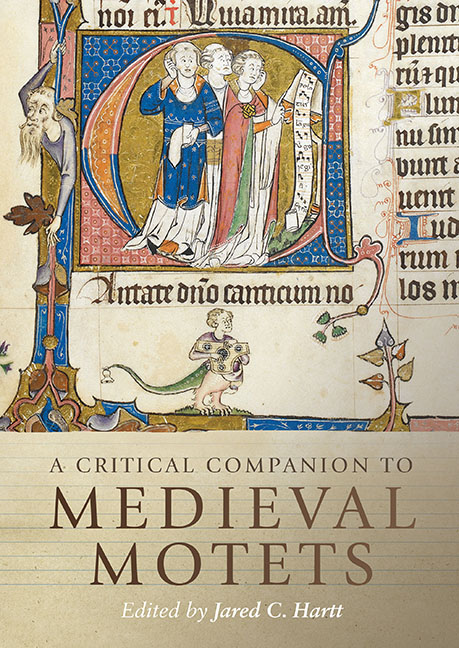Book contents
- Frontmatter
- Dedication
- Contents
- List of Figures
- List of Music Examples
- List of Tables
- List of Contributors
- Preface
- Acknowledgments
- Abbreviations
- Introduction: Approaching Medieval Motets
- 1 The Genre(s) of Medieval Motets
- 2 Origins and Interactions: Clausula, Motet, Conductus
- 3 Tracing the Tenor in Medieval Motets
- 4 Isorhythm
- 5 Notation
- 6 Thirteenth-Century Motet Functions: Views through the Lens of the Portare Motet Family
- 7 A Prism of its Time: Social Functions of the Motet in Fourteenth-Century France
- 8 Motets, Manuscript Culture, Mise-en-page
- 9 Clerics, Courtiers, and the Vernacular Two-Voice Motet: The Case of Fines amouretes / Fiat and the Roman de la poire
- 10 When Words Converge and Meanings Diverge: Counterexamples to Polytextuality in the Thirteenth-Century Mote
- 11 Motets in Chansonniers and the Other Culture of the French Thirteenth-Century Motet
- 12 Building a Motet around Quoted Material: Textual and Musical Structure in Motets Based on Monophonic Songs
- 13 The Duet Motet in England: Genre, Tonal Coherence, Reconstruction
- 14 Materia Matters: Reconstructing Colla/Bona
- 15 Machaut’s Motet 10 and its Interconnections
- 16 A Motet Conceived in Troubled Times: Machaut’s Motet 22
- 17 A Motet Ahead of its Time? The Curious Case of Portio nature/Ida capillorum
- Bibliography of Works Cited
- Select Glossary
- Index of Cited Motets
- General Index
- Studies in Medieval and Renaissance Music
5 - Notation
Published online by Cambridge University Press: 21 October 2020
- Frontmatter
- Dedication
- Contents
- List of Figures
- List of Music Examples
- List of Tables
- List of Contributors
- Preface
- Acknowledgments
- Abbreviations
- Introduction: Approaching Medieval Motets
- 1 The Genre(s) of Medieval Motets
- 2 Origins and Interactions: Clausula, Motet, Conductus
- 3 Tracing the Tenor in Medieval Motets
- 4 Isorhythm
- 5 Notation
- 6 Thirteenth-Century Motet Functions: Views through the Lens of the Portare Motet Family
- 7 A Prism of its Time: Social Functions of the Motet in Fourteenth-Century France
- 8 Motets, Manuscript Culture, Mise-en-page
- 9 Clerics, Courtiers, and the Vernacular Two-Voice Motet: The Case of Fines amouretes / Fiat and the Roman de la poire
- 10 When Words Converge and Meanings Diverge: Counterexamples to Polytextuality in the Thirteenth-Century Mote
- 11 Motets in Chansonniers and the Other Culture of the French Thirteenth-Century Motet
- 12 Building a Motet around Quoted Material: Textual and Musical Structure in Motets Based on Monophonic Songs
- 13 The Duet Motet in England: Genre, Tonal Coherence, Reconstruction
- 14 Materia Matters: Reconstructing Colla/Bona
- 15 Machaut’s Motet 10 and its Interconnections
- 16 A Motet Conceived in Troubled Times: Machaut’s Motet 22
- 17 A Motet Ahead of its Time? The Curious Case of Portio nature/Ida capillorum
- Bibliography of Works Cited
- Select Glossary
- Index of Cited Motets
- General Index
- Studies in Medieval and Renaissance Music
Summary
THE TRAJECTORY of music notation's development is inextricably linked with the genre of the motet. The thirteenth-century motet made new demands upon the existing notation system, specifically with respect to the notation of rhythm. The syllabic settings of texts in the motet's upper voices required a notation that could distinguish durations between single notes drawn as individual note shapes. In polyphony, prior to the emergence of the motet, the grouping of notes in ligatures indicated specific rhythmic patterns, but when one pitch was associated with one syllable of text, these ligatures were broken apart. There were syllabic settings of texts that used single note shapes prior to the motet – the conductus, for example – but the coordination of one or more syllabically set upper voices that sang different texts accompanied by a slower-moving tenor led notators to seek a greater specificity with respect to the relationship between notational glyph and the duration it signified. This would eventually result in the oneto- one correspondence between graphic appearance and duration inherent in modern notation. The current chapter examines four specific moments along this trajectory, where notational ambiguities were resolved with codifications that in turn fostered further ambiguities. I focus first on a selection of motets transmitted in more than one manuscript that offer opportunities to examine how the same musical content was represented in older and newer notations, with the caveat that the timeline of notational developments is complex, and often cannot be represented in tidy chronologies. I close with an example that demonstrates how fourteenth-century motet composers experimented with the precision afforded by newly invented techniques of notation, a precision that had a direct impact on the stylistic development of fourteenth-century polyphony.
NOTATIONS CUM LITTERA
The cum littera notation of the first motet manuscripts – literally ‘with text’, that is, music settings that are syllabic rather than primarily melismatic – is often described as rhythmically ambiguous. While the patterning of ligature groups indicated specific rhythmic patterns in Notre-Dame discant, in motets, ligatures are used infrequently, especially in the texted upper parts, since single note shapes better accommodated motets’ predominantly syllabic text settings.
- Type
- Chapter
- Information
- A Critical Companion to Medieval Motets , pp. 103 - 130Publisher: Boydell & BrewerPrint publication year: 2018



